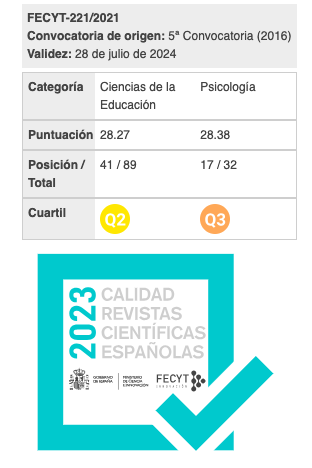Eye of the Beholder: Investigating the Interplay between Inquiry Role Diversification and Social Perspective Taking
Keywords:
Downloads
Abstract
Students and teachers engage in specific roles in classrooms, and within inquiry classrooms, these roles tend to be more varied compared to traditional settings. Teachers may take on traditional student roles including the role of learner, and students, for example, take on the additional role of question asker, traditionally reserved for the role of a teacher. Several of these roles are specific to perspective taking, in particular, social perspective taking (SPT). SPT is critical to successful social interactions and, because group work occurs frequently within inquiry-based teaching and learning environments, a better understanding of SPT roles is required. SPT roles within two different inquiry classrooms were closely examined through audiorecorded group interactions. Additional data were collected in the form of questionnaires, interviews, student and teacher log responses, and field notes. Two teachers and eight students participated. Social perspective-taking roles were dynamic and susceptible to influences including the nature of the classroom activities and instructional choices, student personality differences, and group-work dynamics. All participants adopted SPT roles, however, students who played an active role in choosing their work partners and who were assigned a task that required a consideration of the audience’s understanding tended to adopt more Imagine Other roles as opposed to Imagine Self roles and also adopted more emotionally-based SPT roles compared to students in teacher-formed groups who were assigned more cognitively-based assignments. Implications for researchers, consultants, and students and teachers were discussed.
Downloads
References
Abele, A. E., & Wojciszke, B. (2007). Agency and communion from the perspective of self versus others. Journal of Personality and Social Psychology, 93, 751-763. doi:10.1037/0022-3514.93.5.751
Google Scholar CrossrefAnderson, L., & Burns, R. (1989). Research in classrooms: The study of teachers, teaching, and instruction. Oxford, England: Pergamon Press.
Google Scholar Crossref[Author 1] Details removed for blind review.
Google Scholar Crossref[Author 2] Details removed for blind review.
Google Scholar Crossref[Author 3] Details removed for blind review.
Google Scholar Crossref[Author 4] Details removed for blind review.
Google Scholar Crossref[Author 5] Details removed for blind review.
Google Scholar Crossref[Author 6] Details removed for blind review.
Google Scholar Crossref[Author 7] Details removed for blind review.
Google Scholar CrossrefBatson, C. D., Early, S., & Salvarani, G. (1997). Perspective taking: Imagining how another feels versus imagining how you would feel. Personality and Social Psychology Bulletin, 23, 751-758. doi:10.1177/0146167297237008
Google Scholar CrossrefBerk, L. E. (1989). Child development. Boston, MA: Allyn & Bacon.
Google Scholar CrossrefBernstein, W. M., & Davis, M. H. (1982). Perspective-taking, self-consciousness, and accuracy in person perception. Basic and Applied Social Psychology, 3, 1-19. doi:10.1207/s15324834basp0301_1
Google Scholar CrossrefBlakar, R. M. (1973). An experimental method for inquiring into communication. European Journal of Social Psychology, 3, 415–425. doi:10.1002/ejsp.2420030405
Google Scholar CrossrefCaravita, S. C. S., Di Blasio, P., & Salmivalli, C. (2009). Unique and interacting effects of empathy and social status on involvement in bullying. Social Development, 18, 140-163. doi:10.1111/j.1467-9507.2008.00465.x
Google Scholar CrossrefCarney, D. R., & Harrigan, J. A. (2003). It takes one to know one: Interpersonal sensitivity is related to accurate assessments of others’ interpersonal sensitivity. Emotion, 2, 194-200. doi:10.1037/1528-3542.3.2.194
Google Scholar CrossrefChandler, M. J. (1973). Egocentrism and antisocial behavior: The assessment and training of social perspective-taking skills. Developmental Psychology, 9, 326-332. doi:10.1037/h0034974
Google Scholar CrossrefChandler, M., & Helm, D. (1984). Developmental changes in the contributions of shared experience to social role-taking competence. International Journal of Behavioral Development, 7, 145-156. doi:10.1177/016502548400700203
Google Scholar CrossrefCrawford, B. A. (2000). Embracing the essence of inquiry: New roles for science teachers. Journal of Research in Science Teaching, 37, 916-937. doi:10.1002/1098-2736(200011)37:9<916::AID-TEA4>3.0.CO;2-2
Google Scholar CrossrefDavis, M. H. (1980). A multidimensional approach to individual differences in empathy. Catalog of Selected Documents in Psychology, 10, 85.
Google Scholar CrossrefDunn, J., Brown, J., Slomkowski, C., Tesla, C., & Youngblade, L. (1991). Young children’s understanding of other people’s feelings and beliefs: Individual differences and their antecedents. Child Development, 62, 1352-1366. doi:10.1037/0012-1649.32.3.442
Google Scholar CrossrefFlavell, J. H., Everett, B. A., Croft, K., & Flavell, E. R. (1981). Young children’s knowledge about visual perception: Further evidence for the Level 1-Level 2 distinction. Developmental Psychology, 17, 99-103. doi:10.1037/0012-1649.17.1.99
Google Scholar CrossrefFlavell, J. H., Flavell, E. R., Green, F. L., & Wilcox, S. A. (1980). Young children’s knowledge about visual perception: Effect of observer’s distance from target on perceptual clarity of target. Developmental Psychology, 16, 10-12. doi:10.1037/0012-1649.16.1.10
Google Scholar CrossrefFlavell, J. H., Shipstead, S. G., & Croft, K. (1978). Young children’s knowledge about visual perception: Hiding objects from others. Child Development, 49, 1208-1211. Retrieved from http://www.jstor.org/stable/1128761
Google Scholar CrossrefGalinsky, A. D., & Moskowitz, G. B. (2000). Perspective-taking: Decreasing stereotype expression, stereotype accessibility, and in-group favoritism. Journal of Personality and Social Psychology, 78, 708-724. doi:10.1037/0022-3514.78.4.708
Google Scholar CrossrefGehlbach, H. (2004). A new perspective on perspective taking: A multidimensional approach to conceptualizing an aptitude. Educational Psychology Review, 16, 207-234. doi:10.1023/B:EDPR.0000034021.12899.11
Google Scholar CrossrefGehlbach, H. (2011). Making social studies social: Engaging students through different forms of social perspective taking. Theory Into Practice, 50, 311-318. doi:10.1080/00405841.2011.607394
Google Scholar CrossrefGehlbach, H., & Brinkworth, M. E. (2012). The social perspective taking process: Strategies and sources of evidence in taking another’s perspective. Teachers College Record, 114, 1-29. Retrieved from http://www.tcrecord.org/
Google Scholar CrossrefGehlbach, H., Brinkworth, M. E., & Harris, A. D. (2011, April). The promise of social perspective taking to facilitate teacher-student relationships. Paper presented at the annual meeting of the American Educational Research Association, New Orleans, LA. Retrieved from http://www.eric.ed.gov/
Google Scholar CrossrefGehlbach, H., Brinkworth, M. E., & Wang, M.-T. (2012). The social perspective taking process: What motivates individuals to take another’s perspective? Teachers College Record, 114, 197-225. Retrieved from http://www.tcrecord.org/
Google Scholar CrossrefGehlbach, H., Brown, S. W., Ioannou, A., Boyer, M. A., Hudson, N., Niv-Solomon, A., . . . Janik, L. (2008). Increasing interest in social studies: Stimulating simulations, self-efficacy, and social perspective taking. Contemporary Educational Psychology, 33, 894-914. doi:10.1016/j.cedpsych.2007.11.002
Google Scholar CrossrefGehlbach, H., Young, L. V., & Roan, L. K. (2012). Teaching social perspective taking: How educators might learn from the Army. Educational Psychology: An International Journal of Experimental Educational Psychology, 32, 295-309. doi:10.1080/01443410.2011.652807
Google Scholar CrossrefGillespie, A., & Richardson, B. (2011). Exchanging social positions: Enhancing perspective taking within a cooperative problem solving task. European Journal of Social Psychology, 41, 608-616. doi:10.1002/ejsp.788
Google Scholar CrossrefHale, C. L., & Delia, J. G. (1976). Cognitive complexity and social perspective-taking. Communication Monographs, 43, 195-203. Retrieved from http://www.tandfonline.com/toc/rcmm20/current
Google Scholar CrossrefHeagle. A. I., & Rehfeldt, R. A. (2006). Teaching perspective-taking skills to typically developing children through derived relational responding. Journal of Early and Intensive Behavioral Intervention, 3, 1-34. Retrieved from http://www.baojournal.com/JEIBI/jeibi-index.html
Google Scholar CrossrefJohnson, D. W. (1975). Cooperativeness and social-perspective taking. Journal of Personality and Social Psychology, 31, 241-244. doi:10.1037/h0076285
Google Scholar CrossrefKohlberg, L. (1969). Phase and sequence: The cognitive developmental approach to socialization. In D. Goslin (Ed.), Handbook of socialization, theory and research (pp. 347-480). New York, NY: Academic Press.
Google Scholar CrossrefLaMare, L. J., & Rubin, K. H. (1987). Perspective taking and peer interaction: Structural and developmental analyses. Child Development, 58, 306-315. doi:10.2307/1130508
Google Scholar CrossrefLee, V. S. (2012). What is inquiry-guided learning? New Directions for Teaching and Learning, 129, 5-14. doi:10.1002/tl.20002
Google Scholar CrossrefLincoln, Y. S., & Guba, E. G. (1985). Naturalistic inquiry. Newbery Park, CA: Sage.
Google Scholar CrossrefLlewellyn, D. (2002). Inquire within: Implementing inquiry-based science standards. Thousand Oaks, CA: Corwin Press.
Google Scholar CrossrefMasangkay, Z. S., McClusky, K. A., McIntyre, C. W., Sims-Knight, J., Vaughn, B. E., & Flavell, J. H. (1974). The early development of inferences about the visual percepts of others. Child Development, 45, 357-366. Retrieved from http://www.blackwellpublishing.com/journal.asp?ref=0009-3920&site=1
Google Scholar CrossrefMiles, M. B., & Huberman. A. M. (1994). An expanded sourcebook: Qualitative data analysis (2nd ed.). Thousand Oaks, CA: Sage.
Google Scholar CrossrefMischo, C. (2005). Promoting perspective coordination by dilemma discussion: The effectiveness of classroom group discussion on interpersonal negotiation strategies of 12-year-old students. Social Psychology of Education, 8, 41-63. doi:10.1007/s11218-004-1884-y
Google Scholar CrossrefNational Research Council. (1996). National science education standards: Observe, interact, change, learn. Washington, DC: National Academy Press. Retrieved from http://www.nap.edu/openbook.php?record_id=4962&page=R1
Google Scholar CrossrefOrbell, J., & Dawes, R. (1981). Social dilemmas. In G. M. Stephenson, & J. H. Davis (Eds.), Progress in applied social psychology (Vol. 1, pp. 37-65). Chichester, England: Wiley.
Google Scholar CrossrefPiaget, J. (1954). The construction of reality in the child. New York, NY: Basic Books.
Google Scholar CrossrefPillow, B. H. (1989). Early understanding of perception as a source of knowledge. Journal of Experimental Child Psychology, 47, 116-129. doi:10.1016/0022-0965(89)90066-0
Google Scholar CrossrefPillow, B. H. (1995). Two trends in the development of conceptual perspective-taking: An elaboration of the passive-active hypothesis. International Journal of Behavioral Development, 18, 649-676. doi:10.1177/016502549501800405
Google Scholar CrossrefRosser, R. A., & Lane, S. (1993). Children’s computation of viewpoint from locational descriptions: Initial steps in the coordination of perspectives. Child Study Journal, 23, 1-16. Retrieved from http://www.questia.com/library/p179/Child%20Study%20Journal
Google Scholar CrossrefSchultz, L. H., Yeates, K. O., & Selman, R. L. (1989). The Interpersonal Negotiation Strategies (INS) interview: A scoring manual. Cambridge, MA: Harvard Graduate School of Education.
Google Scholar CrossrefSelman, R. (1971). Taking another’s perspective: Role-taking development in early childhood. Child Development, 42, 1721-1734. Retrieved from http://www.blackwellpublishing.com/journal.asp?ref=0009-3920&site=1
Google Scholar CrossrefSelman, R. L. (1980). The growth of interpersonal understanding: Developmental and clinical analyses. New York, NY: Academic Press.
Google Scholar CrossrefSelman, R. L., & Byrne, D. F. (1974). A structural-developmental analysis of levels of role taking in middle childhood. Child Development, 45, 803-806. Retrieved from http://www.wiley.com/bw/journal.asp?ref=0009-3920&site=1
Google Scholar CrossrefSnow, R. E. (1996). Aptitude development and education. Psychology, Public Policy, and Law, 2, 536-560. doi:10.1037/1076-8971.2.3-4.536
Google Scholar CrossrefStinson, L., & Ickes, W. (1992). Empathic accuracy in the interactions of male friends versus male strangers. Journal of Personality and Social Psychology, 62, 787-797. doi:10.1037/0022-3514.62.5.787
Google Scholar CrossrefSutton, J., Smith, P. K., & Swettenham, J. (2010). Social cognition and bullying: Social inadequacy or skilled manipulation? British Journal of Developmental Psychology, 17, 435-450. doi:10.1348/026151099165384
Google Scholar CrossrefTarshis, E., & Shore, B. M. (1991). Perspective taking in high and above average IQ preschool children. European Journal for High Ability, 2, 201-211. doi:10.1080/0937445910020209
Google Scholar CrossrefTaylor, M. (1988). Conceptual perspective taking: Children’s ability to distinguish what they know from what they see. Child Development, 59, 703-711. doi:10.2307/1130570
Google Scholar CrossrefTurner, J. C., & Meyer, D. K. (2000). Studying and understanding the instructional
Google Scholar Crossrefcontexts of classrooms: Using our past to forge our future. Educational
Google Scholar CrossrefPsychologist, 35, 69-85.doi:10.1207/S15326985EP3502_2
Google Scholar CrossrefVERBI. (2012). MAXQDA Qualitative Data Analysis Software. Berlin, Germany: Sozialforschung.
Google Scholar CrossrefDownloads
Published
Almetric
Dimensions
How to Cite
Issue
Section
License
All articles are published under Creative Commons copyright (CC BY). Authors hold the copyright and retain publishing rights without restrictions, but authors allow anyone to download, reuse, reprint, modify, distribute, and/or copy articles as the original source is cited.
















